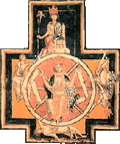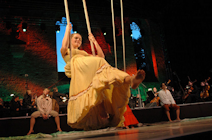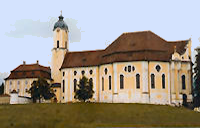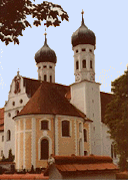
Fortune's Wheel
(From the original MS) my first love Norah introduced me to Carl Orff's setting of some of the Carmina Burana, a vast collection of medieval songs written mainly in Latin. I was so struck by these that I spent odd moments of the next ten years trying to produce a singable translation of them into equivalent English verse. My agent offered the result to Betty Radice, then editor of the Penguin Classics series, and she was suffiently struck by them to invite me to translate a much larger selection from the original manuscript. Thus, whereas Orff set about 20 titles, representing some five per cent of the whole, I expanded this to about 70, representing some 20 per cent, and in 1986 the result was published in Penguin Classics as Selections from the Carmina Burana.

My translations accompanied a
choreographed performance of the
cantata by the Tallinn Philharmonic
Orchestra at the annual
Birgitta Festival It was republished in July 2007 by Penguin Group (USA) Incorporated (ISBN: 0140444408; ISBN-13: 9780140444407) and is now available on Kindle. The greatest pleasure of this self-imposed and otherwise profitless task was a visit to the monastery where the manuscript was found, thanks to my friends Tom and Margot Werneck, and to the Bavarian State Museum in Munich, where I was granted access to the original manuscript. The following pages contain my version of all the Buranian lyrics that were set by Orff - not entirely word for word from the Penguin Classic, as I still keep tinkering with particularly recalcitrant bits and pieces of them. In fact, I'm inclined to do this every time I bring it up on screen. Here are some introductory paragraphs from my introduction to the published selection.
BACKGROUND
Outside a specialised readership

Benediktbeuern Monastery (photos: David Parlett) Carmina Burana is probably best known as the title of a popular work for chorus and orchestra by Carl Orff. The hour-long cantata, much performed and recorded, is an exuberant setting of some twenty poems in Medieval Latin and Middle High German from a thirteenth-century manuscript found at the Bavarian monastery of Benediktbeuern (sometimes spelt Benediktbeuren, which is unusual though I understand to be historically defensible.) The manuscript contains about 250 essentially secular lyrics by various authors, of varying degrees of literary merit, and covering a range of themes including satire, literary and liturgical parody, love songs, drinking songs, and stories from the classics. As the largest surviving anthology of Medieval Latin poetry, the contents of the manuscript represent the last outpourings of poets who still used that lingua franca of Christendom as fluently as their individual native tongues. The following translation of the songs selected by Orff are not intended to be word-for-word renderings. My object was to produce a version that would both -
- reproduce the same metres and rhyme-schemes as the originals, which necessarily entails a degree of versifier's licence, and
- be singable to Orff's eminently singable tunes, which entails the avoidance of such complications as awkward consonant clusters and closed vowels on high notes.
CONTENTS
Composing in 1936, Orff necessarily based his setting on a rescension of the text made in 1847 by Johann Andreas Schmeller of the Munich Central Library. The authoritative modern edition occupies five books edited by Alfons Hilka, Otto Schumann and Bernhard Bischoff and published, respectively, in 1930, 1941, 1970, 1982, and 1991. My published translations are based on the modern edition, but where Orff's interpretation has been significantly affected by that of Schmeller I have reverted to the latter. The contents of the Carmina Burana fall into five sections.- CB 1 - 55 are poems of a moral, religious and didactic nature now generally categorised under the heading "Moral/Satirical". They account for about 20 per cent of the extant text. CB1, of which only the last lines are preserved, must have been preceded by an unknown quantity of other poems in the same category (perhaps even by an entire section, devoted, for example, to hymns and religious poetry of a pious rather than satirical nature).
- CB56 - 186, collectively referred to as "Love Songs", form the largest section of the manuscript, accounting for just under 50 per cent of actual text. The section was originally longer, since at least one gathering of folios is known to be missing. These include also songs of spring and nature, which Orff counted as a separate section (as have I).
- CB 187 - 226 constitute the "Drinking and Gaming Songs" and form about 12 per cent of the text.
- A fourth category may be distinguished for the two religious plays constituting CB227 and CB228. These bring the manuscript up to folio 106.
- A fifth category may be distinguished for all supplementary material added at a later date from the main body. Most of this occupies folios 107-12 and the unbound Fragmenta. Following the Hilka-Schumann-Bischoff critical edition, supplementary pieces are numbered separately and distinguished from the main text by an asterisk. CB 1a* - 26a* constitute about 15 per cent of the whole.